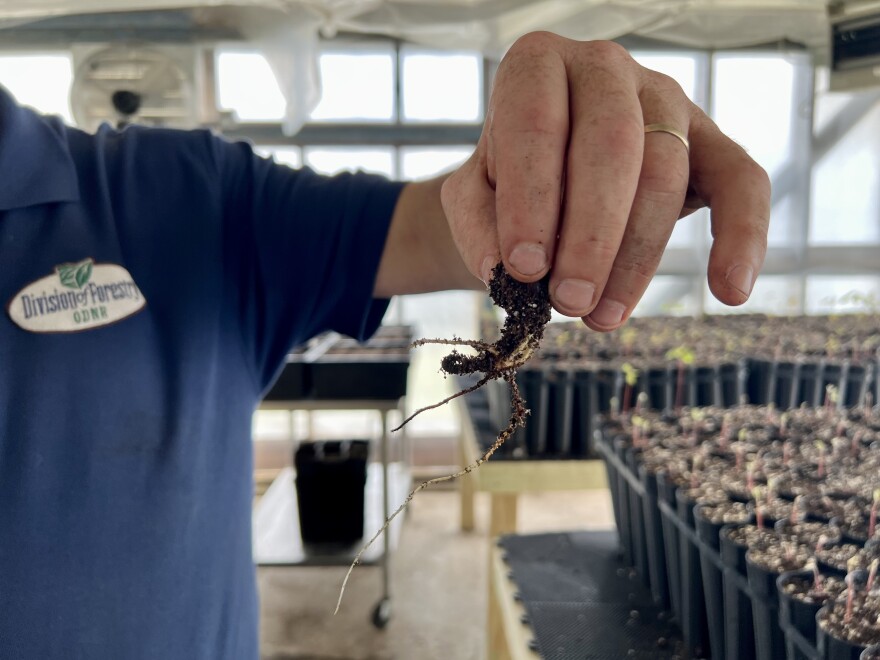There’s an old greenhouse off a rural road in Zanesville, Ohio. It sat empty and unused for decades, but now it’s quite literally coming back to life.
Inside, Carla Jarvis stood at a soil-covered table beside a bucket of black walnuts and a bag of chestnut seeds.
“They’ve got a good sprout on them right now,” she said, holding one up to the light.
She poked a hole in the soil with her gloved hand and placed a seed inside.
“We just keep making them nice little homes,” she said.

When one plastic planter is full, another greenhouse worker sprayed it with water and set it on a table beside rows and rows of other freshly planted seeds.
The two-man team has planted about 700 on this day alone. And they have a lot more to go.
“When we get this whole building here filled up, we should have over 17,000 seeds in here,” said Nate Linscott, a forest manager with the Ohio Department of Natural Resources’ Division of Forestry.
And the planting won’t stop there.
Outside, a crew is already clearing the way for a new greenhouse and hoop houses, which will house more than a million additional seedlings.
The Buckeye State Tree Nursery
Ohio lawmakers passed establishing this earlier this year, in order to meet the state’s growing demand for trees.
Decades ago, the state had several tree nurseries: one here in Zanesville, another in Marietta, and a third in Green Springs closer to Lake Erie.
But as industry shifted and paper needs dried up, they started to close. The state’s shut down in 2008.
The need for trees, however, didn’t entirely disappear.
“People from Ohio are still buying seedlings, but they're buying them from outside of Ohio,” said Stephen Rist, a district manager for the Division of Forestry and one of the people overseeing the new nursery.

By his count, the state bought about 1.5 million seedlings from outside of the state last year.
For a long time, many of those seedlings came from West Virginia. But that state down in 2021.
“So there has not been the ability to buy bare root seedlings with this Ohio ecoregion,” Rist said. “And we don’t want to get stuff from Alabama.”
Trees from outside the region aren’t as suited to Ohio’s climate and growing seasons, Rist explained.
“So what we're trying to do is collect as much native seed as we can from here, and then it will be best for Ohio in this region.”
As seeds fall from trees all over the state, greenhouse workers and volunteers collect them.
Those are the seeds in the bags and buckets before Carla Jarvis. Several hundred hickory seeds are from Gov. Mike DeWine’s Greene County property.
“Once we get a whole tray [planted], we'll go back and recover them and water them,” she said. “And then we send them off to start growing.”
From seeds to trees
Eventually, when these sprouted seeds grow into tiny trees, they’ll go all over Ohio.
They’ll be planted on in the southeast, as between acres of farmland in the northwest, and along the to stabilize shores.

“If you got a big gnarly sycamore, the roots are coming out of it, but they're holding in the bank so that it doesn't keep pushing further,” Rist said, “because rivers like to meander.”
The state will contribute some seedlings to the , as they endeavor to plant 250,000 trees by 2026.
And eventually, some will be available for public purchase too, Rist said.
No matter where they end up, someday these baby trees will spread their roots and reach to the Ohio sky.
For now, though, they’re waiting to be planted.


